Using downscreens
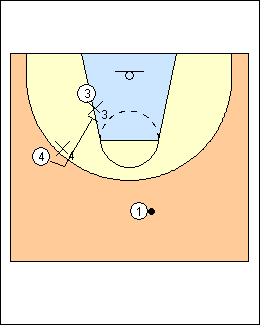 | 1 Dave Smart Carleton doesn't do a lot of same-size screening since other teams switch. Defensively on a downscreen, they want to get attackers to go where they don't want to go, force the cutter to make the wrong read, e.g., on a big-to-little downscreen, force the little cutter to curl (chase him out), the big has to vacate. The cutter will probably cut to the wing but that is easy to defend even without switching. In setting a downscreen, the screener first sells opposite, stepping to the ball. |
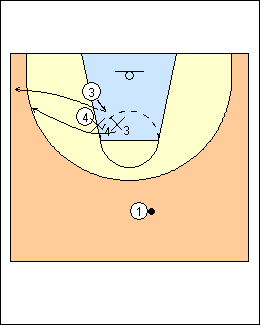 | 2 Chase The cutter wants to get to the perimeter. When the xcutter wants to chase around the screen, the cutter steps up the middle (sell up the line), the screener readjusts his screen (reverse pivots on his bottom foot), 9 out of 10 times the xcutter will gap (under both the screener and xscreener), so the cutter fades to the corner. On a pass to 3, 4 seals with a reverse pivot on this bottom (left) foot. Coach K - on a pass to 3, 4 steps inside with his right foot and reverse pivots on it to seal X4 for a baseline pass. If X4 takes away the baseline pass, 4 reverse pivots on his left (outside) foot to seal for a hi-lo pass from 1 (on a return pass from 3). |
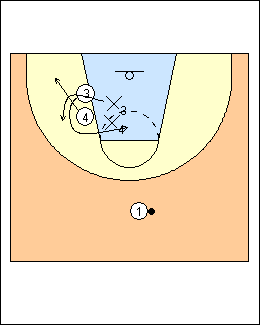 | 3 If the xcutter chases, the cutter curls tight (a collision with xscreener) and the screener steps off to a 21 position (triangling), with his back to the baseline, looking for a power lay-up on a pass over the top from 1.. If there is no pass, the screener vacates to the perimeter if he is a shooter, otherwise he sets a second screen for the cutter to vacate. The cutter is in no rush on his read - sell, set (get shoulder to hip with the screener, hold for a two-count), read, vacate. Don't vacate to where you are useless. Running away from the basket to catch the ball is a bad move except late in the shot clock. Don't round the curl to catch at the foul line going away. Billy Donovan - if 3 tight curls, 4 will step back to the baseline looking for a throw-back on a pass to 3. 4 anticipates the curl if X3 goes under the screen (see Fast Breaks - Florida 2005). coachesclipboard.ca - 3 curls the screen if X3 tails him, and should run into the screener's defender who is bumping him (cut through contact), helping the second cutter (screener) get open. If the cutter looks at the ball or puts his hands up it will be considered incidental contact rather than an illegal screen. If the screener is a shooter he should second cut to the perimeter, if not he can duck in as the cutter goes by. Another option on a curl is that the cutter goes above the bump for a pass and the screener second cuts directly to the basket for a pocket pass. Jamie Dixon - curl and screen is an option, 3 curls the screen then screens for 4 (a shooter). Tony Barone - 3 curls to the elbow if his defender chases, if he curls into the lane his defender can catch up and there is a shot blocker. Don't pop to the wing, there is not enough pressure on the defence. 4 steps out along the baseline looking for a pass from the top. |
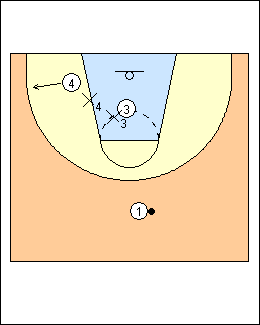 | 4 Here screener 4 is a shooter and vacates to the perimeter from the 21 position. 3 could then be involved in another screening action, e.g., a little to big cross-screen for the other post. |
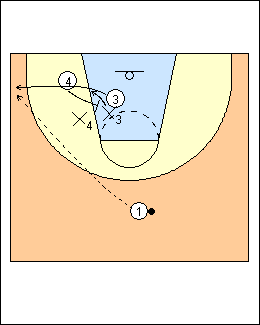 | 5 Here 4 is a non-shooter, and can't really post up unless 3 clears out, so 4 sets a second screen for 3 to vacate, X3 chases. On a pass to the cutter, the screener seals (reverse pivots on his bottom foot). If you get the ball in the corner, make a play, you can't hold it. |
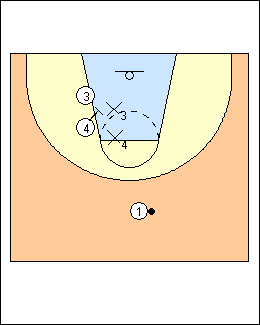 | 6 Gapping The xcutter wants to gap (usually on a non-shooter). The screener sets an area screen as high a possible. The xscreener leaves a gap for the xcutter. |
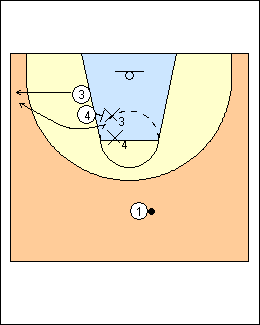 | 7 The screener readjusts with a reverse pivot on his bottom foot, the cutter flares to the corner. The screener posts up wanting the ball from the top (ducks up and in with his left foot), but is expecting it from the corner (3 is not a shooter), and creating a better angle for it. He will reverse pivot on his left foot on a pass to 3. If X4 gets in a "straight-line" situation directly between 4 and the ball, he can't defend there. If his back is to the ball, 1 looks for an over-the-top pass to 4; if X4 panics and faces the ball, 4 vacates, he may not get an immediate pass, but then X4 will turn around and 4 ducks in. (They do a lot of 3 on 3 no-dribble and pass any time there is a straight-line.) In a "gorilla" situation where the xcutter holds the cutter, the cutter steps back towards the baseline, and expects a gap. Billy Donovan - if 3 fades and gets a pass, 4 seals. When X3 goes over the screen, 4 starts to flash, stepping up the lane with his left foot, creating more room for a seal, and reverse pivots on his left foot if there is a pass to 3. If 3 fades and does not get a pass, 4 will flash to the elbow for a pass, 3 cuts backdoor, 1 can cut for a hand-off then go to the wing. coachesclipboard.ca - downscreening with a post-up player is one tactic to get the ball inside, 4 downscreens towards the block, front pivots (with the foot furthest from the ball), swims over, and quickly closes the gap between himself and X4 (who has jumped to the ball), preventing X4 from getting over top on the pivot. 3 cuts to the wing for a pass from 1, and will often have to take one dribble towards the baseline to improve the passing angle. A high-low downscreen is similar action, with the ball on a wing the post-up player starts high in the middle, screens down, front pivots and swims over his defender, the cutter gets a high pass from the wing and makes a two-hand overhead pass into the screener. |
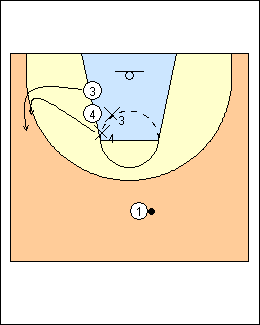 | 8 Switch Switching is a solid way to defend, but a big-to-little downscreen can still cause mismatches (Carleton won't set a little-to-big downscreen unless the big is a shooter, but even then the problem is not posting with the big.) It looks to the attackers like a flare (gapping) situation, and they play it that way. Even though it's a switch, the screener readjusts the screen with a reverse pivot on his bottom foot to get one step closer to sealing up the lane, then posts to the point, stepping over as high as he can into the lane with his left foot. The cutter flares to the corner, then triangles high when the defending post comes out on him. Bob Huggins - screen away with your butt to the ball so the cutter can curl it, then you come straight back to the ball, the passer has to have someone to pass to. If defenders switch, 4 can slip the screen or 3 can make a switch cut - curl around the screen and screen for 4, who curls and 3 comes back to the ball. Have shooters screen for non-shooters, non-shooters backcut, they don't screen. Rick Majerus - don't set a downscreen too low or inside, it distorts screening angles; a lot of switching defences have trouble with a tight curl or backcut (the first look). |
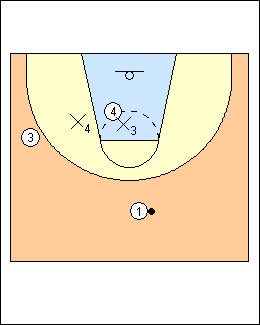 | 9 If 3 is denied, 1 passes into the post. If X4 zones (helps) on 4, 1 passes to 3 for a big on little close-out. |
This page was made with Basketball playbook from Jes-Soft